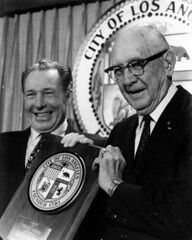Before Hollywood meant celebrities and film reels, there was the Cahuenga Valley and Colegrove that gave way to a community called Hollywood. Before the Walk of Fame and the movie premieres and footprints in cement, there was the building of a city that was Hollywood. And who drove this development? Aside from Wilcox and Cole who started things out, it was Charles Edward Toberman who is credited with building Hollywood into what is known worldwide today. From commercial stores to homes and from movie studios to movie theaters, C.E. Toberman did it all. Credited with building 29 commercial structures over 70 years, he is known as the most prolific developer in Hollywood. The oldest retail building on Hollywood Boulevard today, at 6410 Hollywood Boulevard (the former "Woolworth Building"), was a Toberman building. In fact, 6780 Hollywood Boulevard was known as the CE Toberman Building, the site of his first office in a previous building than what now exists (Ripley's Believe it or Not).
Read more...
Toberman was born in 1880 and was the nephew of two-time Mayor James R. Toberman (whose house in Hollywood, a City-designated historic-cultural landmark on Harvard just north of Hollywood Boulevard in CD4, was next door to Charles Toberman's house). He moved from Texas to Los Angeles in 1902 (or 1905 - there is some discrepancy) with his wife and $30. He opened an insurance and real estate firm in 1907 in an office at the above mentioned Hollywood & Highland location, when Hollywood Boulevard was known as Prospect Boulevard (his office was actually at 1717 N. Highland Ave.). He served as an appointed City Treasurer when Hollywood was its own municipality in 1909 and chair of the executive committee to fully establish the Hollywood Bowl we know today in 1923 and served as the president of the Hollywood Bowl Association for more than 30 years.
Toberman was known for building large concrete buildings, which were poured in place using steel re-bar, making them extremely strong. Sometimes, the concrete was poured up to three feet thick. He was also known for creating decentralized shopping centers, choosing locations that were considered "outside of town" to group commercial buildings. He acted as a one-man CRA, taking older buildings and replacing them with newer, modern structures that added to the vitality of the area.
He was the living example of free enterprise, and his 1971 biography held that title: "Free Enterprise: Foundation of America's Greatness."
Some of the other buildings and developments Charles E. Toberman is credited with are the Hollywood Center Studios on Las Palmas, Hollywoodland residential development, Outpost Estates, residential tracks in the Valley & Fairfax District, the Chinese Theatre, El Capitan Theatre, the Roosevelt Hotel, the Bekins Building, the Kress Department Store (Frederick's of Hollywood), and the The Hollywood Fire and Safe Building (the Max Factor Building).
Now, if you walk along Hollywood Boulevard and are awed by the landmarks that define one of the most famous streets in the world, you'll understand why in 1972, Charles E. Toberman, at 92 years old, was still known as "Mr. Hollywood." If you stop on that walk at the First National Bank of Hollywood Building (northeast corner of Hollywood & Highland),you can see a plaque that was installed there in his honor by the Hollywood Chamber of Commerce for his vision in making Hollywood what it was in 1972. And today, he still holds that title of "Mr. Hollywood" as his legacy still defines the City street that defines the idea of Hollywood to the world.
The plaque reads:
C.E. Toberman lived to be 101 years old, and until the week before he died at the end of November in 1981, he still frequented his Hollywood haunts of Musso & Frank and the Savings & Loan which he served as Chairman Emeritus.

